
by HOWARD A. ROBERSON
As many recordists know, we've had a long history of hearty recommendations to use bulk erasing, when ever possible, to ensure the lowest possible tape noise. Because it's been the thing to do for the past 30 years, it may be perfectly reasonable to believe that bulk erasing makes sense today. However, after seeing a number of very strong advertising claims and hearing several tales of woe from consumers, I thought the time was right to examine the performance of bulk erasers.
A bulk eraser, or degausses, is basically an accessory device that radiates a strong magnetic field onto a tape in order to erase it. How much erasure occurs depends on the strength of the magnetic field and on the tape's level of coercivity. The higher the coercivity, the stronger the demagnetizing field required for full erasure--whether that field comes from a recorder's erase head or from a separate bulk eraser.
Much of the higher performance of today's tapes comes from their higher coercivities. High-coercivity tapes re quire more bias but are also more resistant to self-erasure. Type I tapes have coercivities from around 300 Oe to over 500 Oe for some premium formulations. The Type II coercivities overlap those of the normal-bias tapes, ranging from less than 450 to at least 700 Oe for the recent Type II metal-particle tapes. Type IV formulations have coercivities of 1,000 Oe or more.
This results in much greater resistance to erasure, accidental or intended.
I should point out that the stated coercivity for a given tape formulation is the average of all its particles. The tape actually includes particles with higher and lower coercivities, the occurrence of both types roughly following a normal distribution curve. This means that a tape with a 500-0e rating would probably have some particles with 700-0e coercivity, and those particles would establish the erasing-field strength needed for complete erasure.
(I refer readers wanting further explanation to "The Mechanism of Magnetic Tape Erasure" by Peter Vogelgesang in the April 1981 issue of Audio.) It is apparent that the erasing field required for metal-particle tapes is much stronger than the field required for many older tape formulations. In fact, with the continuing increase in the coercivity of tapes in general, I had to be skeptical, as I began these tests, at least of the older bulk erasers that had not been designed for such challenges. I noticed on one figure from Nortronics (now The Geneva Group) that the drop in field strength for sever al bulk erasers is 40% or more for each doubling of distance. (The exact drop will depend on the shape of each eraser's field.) This fact of magnetic life requires that the eraser and the tape be in as intimate contact as possible, and perhaps that the tape be turned over to ensure magnetic saturation on each side.
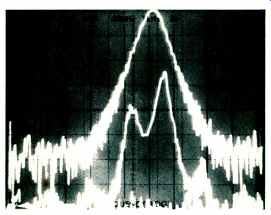
Fig. 1--Comparison of bulk and deck erasure on Maxell XLII-S (Type II)
tape. Top: Spectrum analysis of 1-kHz tone recorded at 250 nWb/m. Middle:
Same tone after degaussing by Tascam E-2A bulk eraser. Bottom: Same tone
after erasure by Nakamichi 582 deck (see text). Scales: Vertical, 10
dB/div.; horizontal, 20 Hz/div.
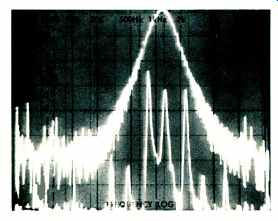
Fig. 2--Spectrum analysis of 1-kHz tone recorded at 250 nWb/m (top) and
same tone after degaussing by Lafayette ML-120 bulk eraser (bottom).
Scales: Same as Fig. 1.
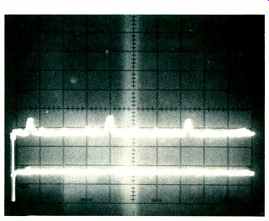
Fig. 3--Amplitude vs. time for playback of 400-Hz, 250-nWb/m tone on Nakamichi
EXII (Type I) cassette after erasure by Lafayette ML-120 (top trace)
and by Nakamichi CR-7A deck (bottom trace). Scales: Vertical, 10 dB/div.;
horizontal, 1 S/div.
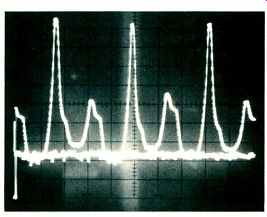
Fig. 4--Same as Fig. 3 but using Nakamichi SX (Type II) cassette.

Fig. 5--Same as Fig. 3 but using Nakamichi ZX (Type IV) cassette.
Measurements
I have an old Lafayette ML-120 bench-type bulk eraser, and I really expected that it would suffer in comparison to newly designed units. I ran tests on it and on the following bulk erasers: The Radio Shack No. 44-233, a hand-held unit which the catalog says can be used for both audio and videotapes; the hand-held Geneva PF-211 video/audio eraser; the bench-type PF-250 Professional eraser from Geneva, and the bench-type Tascam E-2A. Both the Geneva PF-250 and Tascam E-2A have spindles for reel center-holes and adaptors for 10 1/2-inch reels; the PF-250 also has a guide rail for audio and videocassettes.
I don't remember if I ever had any information on the magnetic field generated by my old Lafayette unit. There was no such information supplied with the Radio Shack or Tascam bulk erasers. On the other hand, the Geneva literature lists the surface flux intensity as 2,300 gauss for the PF-211 and 3,000 gauss for the PF-250. The manual with the PF-250 has figures of field versus distance and erasure depth versus signal wavelength. One table in this manual lists the flux intensities required to erase particular tape formulations. Another shows the maximum distances the field would need to reach, either in a single pass or in separate passes on each side, in order to erase common formats ranging from cassette up to 1-inch reels and half-inch videocassettes. The manual also points out that the erasing field in gauss should be 1.5 times the tape's coercivity, all the way out to the maxi mum distance required for erasure (at least halfway through the tape); this information is reflected in the field-distance table. Obviously, wide tapes may have to be turned over to achieve acceptable erasure. In general, the eraser must be brought as close to the tape as possible; other techniques will be discussed later.
For my first erasure test, I used Maxell XLII-S, a Type II cassette tape, on which I had recorded a 1-kHz tone at a level of 250 nWb/m using a Nakamichi 582 deck. A spectrum analyzer scan (the top trace in Fig. 1) was made of the tone in playback. Then the tape was erased on the Tascam E-2A by passing it through the field, flipping it over, and passing it through again. The middle trace of Fig. 1 shows the degree of erasure, which was rather poor-just 20 dB at one point. After erasure by the 582 deck (bottom trace), the analyzer showed no definite signal, just noise spikes 80 dB down.
Figure 2 shows another scan of the 1-kHz tone as recorded (top) and after erasure by the Lafayette ML-120 unit (bottom). The Radio Shack 44-233 did not do as well as either the Lafayette or the Tascam bulk erasers, so it was dropped from the test program. Additional checks with cassette tapes showed that the much older Lafayette was at least as good as the new Tascam E-2A, which was then put aside for the time being.
I realized that the analyzer frequency-scan method was not the best for checking the level of erasure, so I switched to a zero-scan sweep, measuring amplitude over time at the test-signal frequency rather than measuring amplitude versus frequency. I also shifted to a 400-Hz test tone to make degaussing a little more difficult. Figure 3 shows the erasure achieved with a Type I tape (Nakamichi EXII) at 400 Hz for the Lafayette and for another Nakamichi deck, the CR-7A, which proved to be more convenient for these tests. The reference level is at the top of the 'scope's graticle, and the Lafayette trace was raised two divisions for clarity. (The vertical scale is 10 dB/division.) The actual erasure by the Lafayette, therefore, was about 82 dB (close to the noise limit of the analyzer), with the exception of the momentary peaks (more on these later).
The erasure by the deck was at least 83 dB; that's about the noise limit of the analyzer.
Figure 4 shows what happened when I tried erasing another tape, the Type II Nakamichi SX, on the Lafayette unit and the CR-7A deck. In playback, there was a strong cyclical variation in the erasure by the Lafayette, with very brief periods of full erasure alternating with periods in which erasure fell to a mere 5 dB. Erasure by the deck, in contrast, was about 77 dB. Figure 5 shows that a metal-particle tape, Nakamichi ZX, almost completely resisted the erasing field of the Lafayette, while the deck managed an erasure of close to 77 dB.
Figure 6 shows the results obtained with the hand-held Geneva PF-211 bulk eraser on Nakamichi EXII, SX, and ZX tapes. A worthwhile improvement in erasure over the old Lafayette is immediately obvious. The residual signal on EXII (Type I) is buried in the noise floor, from which a few residual peaks emerge from the erased SX (Type II).
The metal tape, ZX, remained untamed, with 50-dB erasure at best.
The basic test was repeated (Fig. 7) using the Geneva PF-250 bench-type eraser, this time comparing just the SX and ZX formulations. Surprisingly, the PF-250 erased the metal tape more completely than the hand-held PF-211 did, but its erasure of the Type II tape was poorer.
At this time, I considered the fact that bench-type bulk erasers come with spindles on which reels of tape can be easily rotated. When the tape is rotated through the eraser's field, particles from all points around the reel are oriented, at least part of the time, for easy demagnetization. By contrast, when a cassette tape pack is passed straight through a bulk eraser's field, there is a 90° variation in the orientation of the tape particles to the field. Some particles are oriented in the same direction as the field, and others are at angles to it. Figure 8 shows what happened when I rotated the SX and ZX tape packs in the center of the Geneva PF-250's top plate, rather than sliding them along the unit's cassette guide rail. The SX erasure was down into the noise, and the ZX erasure improved to 60 dB or better.
With the hand-held PF-211, it had been natural to rotate the cassette or to do a circular scan of the tape pack; the benefits of this can be seen by comparing the lower traces of Fig. 6 (the PF-211, rotated) with those of Fig. 7 (the PF-250, straight pass). Without some form of scanning, the degree of degaussing varies around the circumference of the tape pack, and the residual noise varies cyclically in playback.
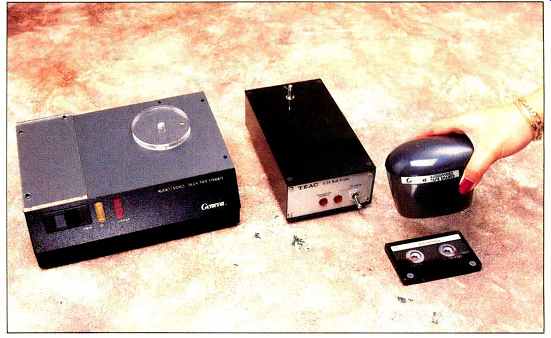
------- Among the bulk erasers examined were Geneva's PF-250, Teac's
Tascam E-2A, and Geneva's PF-211.
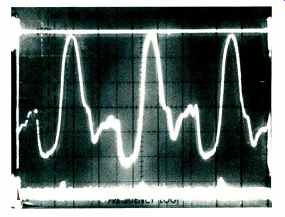
Fig.
6--Erasure of 400-Hz, 250-nWb/m tone on three tape types, rotating Geneva
PF-211 hand-held bulk eraser. Top trace: Tone before erasure. Middle trace:
Nakamichi ZX after erasure. Bottom: Nakamichi SX and EXII, overlapped (see
text). Scales: Same as Fig. 3.
Erasure varies with frequency too. Frequencies lower than 1 kHz or 400 Hz are harder to erase, and so I re corded pink noise on the ZX metal tape to permit seeing erasure across the band and its variation with time.
The hand-held PF-211 was scanned around the cassette in a circle. Figure 9 shows that good erasure of this Type IV tape was not possible with the PF-211. The storage 'scope used here al lowed me to record the entire range of erasure over time for all frequencies in the audio band. The best minimum erasure was 43 dB at 10 kHz, and the best maximum erasure was 54 dB at 5 kHz really unacceptable performance at any frequency.
Figure 10A is a simplified representation of a bulk eraser with a spindle for use with open-reel tapes. The poles which supply the erasing flux are oriented so that the lines of flux lie in the plane of (are tangent to) the magnetic particles in the tape's layers. Because of the original alignment of the particles during manufacture, this relation ship makes erasure easier. When a cassette is passed straight through these same pole pieces, however (Fig. 10B), most of the tape pack is not in good alignment for erasure. At two points, the orientation is very poor for effective degaussing. These poorly erased points are opposite each other in the tape pack, and in playback, the residual spikes might be heard every half-revolution of the pack. Many of the previous figures had the cyclic pattern discussed here, and Fig. 8 showed the great improvement in erasure that is possible with rotation of the cassette pack in the degaussing field. Experiments by R. E. Fayling, of 3M, have revealed that degaussing a tape the hard way, with the tape at right angles to the lines of flux, requires a degaussing field of 2.5 times the tape's coercivity, a field 67% stronger than that needed for degaussing it along the easy axis.
Figure 11 shows the erasure of a 1-kHz tone from a Maxell XL I open-reel tape by the Lafayette and Tascam units. Note that the erasure of this relatively high-frequency tone is a margin al 60 dB and that, with this fairly new tape, the Tascam unit shows no advantage over the old Lafayette. Figure 12 presents the different story resulting when the Geneva PF-211 and PF-250 units were used: Erasure of at least 77 dB was achieved. With the PF-211, I had made a careful, slow spiral scan from the outer edge in to the hub.
TDK SA open-reel tape, an EE type, was used for the final challenge. The Revox A77 recorder I used could erase the 1-kHz tone only 50 dB, although it had achieved at least 77 dB with Maxell XL I. I tried to do a speedy but careful scan with the hand-held PF-211. Figure 13 demonstrates that my spiral was not very smooth or all-covering. The bench-type PF-250 was superior in this test, with complete erasure of over 75 dB (noise limited).
Degaussing Videocassettes
Considering the growing use of Hi-Fi VCRs for audio and the claims of the eraser manufacturers for excellence in degaussing, I also tried the Lafayette and the two Geneva bulk erasers on videocassettes. I made a simple assessment of the erasure of picture and sound in normal ( Beta Ill) mode, using high-grade formulations from BASF, PDMagnetics, Scotch, and TDK. Generally speaking, there was little difference in erasure from one brand to an other. In all cases, the degaussing field was applied to both sides of the video cassette.
The Lafayette was just fair at video erasure and was poor at erasing the sound. When the hand-held Geneva PF-211 was used for a spiral scan over both sides of each tape pack, the era sure was excellent for both video and audio on all formulations.
With the PF-250, I slid the tapes along the guide rail and got good to excellent results on the video and fair to excellent on the audio. When I slid the tapes more through the center of the degaussing area (slightly away from the rail), erasure of both picture and sound slightly improved. The poorly erased portions were cyclic and were time-related to position in the tape pack. I tried rotating the video cassettes on top of the PF-250 but had trouble doing it smoothly. The results were erratic; sometimes the erasure was poor for both video and audio.
The hand-held Geneva PF-211, with a good spiral scan, was able to get a higher effective degaussing field to all sections of the videocassette tape pack than the bench-type PF-250, whether I slid the tape straight through the PF-250's field or rotated the tape pack. In other words, it was less difficult to get easy-axis erasure with the PF-211.
Conclusions and Recommendations
The conclusions I reached after all these experiments emphasize the limitations of bulk erasing (and the limitations of some older tape decks).
Most old and many new bulk erasers cannot adequately erase Type II cassettes, open-reel tapes of the EE type or in the same coercivity range as Maxell XL I, or high-grade videocassettes. No bulk eraser I tried did a good job in degaussing metal-particle cassette tape. Claims by any manufacturer that an inexpensive hand-held unit will erase "all audio tapes" should be rejected-especially as regards metal tapes.
Older open-reel decks, even if they can record on EE tape, might not be able to erase what they have recorded.
Cassette decks are much more successful in degaussing Type IV tapes than even expensive bulk erasers. In general, but particularly for Type II and IV cassettes, erasure is best left to the recordist's deck.
Bulk erasing a tape before recording on it does not seem to improve the S/N of the recording. No matter whether the deck's erase head or the bulk eraser does a better job of degaussing the tape, the residual noise level on a re-recorded tape will stay about the same.
Of the erasers I tested, the hand held Geneva PF-211 was the best overall, for both audio and videotape.
Its price of $54.95 was judged very reasonable for what it can do. Geneva's bench-type PF-250 was the best of the group with EE-type open-reel tapes. Its $400 + price would be a very stiff one for most recordists, but it could be a good investment for some one who does a great deal of taping, particularly on open-reel tapes. Most of the other bulk erasers I tried would be completely acceptable for degaussing lower coercivity open-reel and cassette tapes, but none of the others earn a general recommendation for degaussing of magnetic media.
If you already have a bulk eraser, you should review the technique you use for erasing tapes. For open-reel tapes, bench-type units with spindles will produce the most even demagnetizing fields, as long as rotation is smooth and slow.
It is also essential that the tape be 2 to 3 feet away from the eraser before you turn the eraser off! Otherwise, if the magnetic field collapse at switch-off occurs at the peak of the line-voltage waveform, you risk leaving a saturated signal on the tape.
When using a bulk eraser for cassette tapes, the best procedure is to wind all of the tape to one end, place the cassette so that its tape pack is in the center of the erasing area, rotate the tape pack at least one complete revolution, and remove the tape from the degausser before switching it off. If the tape is a Type II, repeat the pro cess for the second side.
When operating a hand-held bulk eraser, scan the tape pack, following a slow spiral from one edge of the pack to the other, while maintaining intimate contact with the reel or the cassette shell. Repeat on the second side for higher coercivity tapes. If the hand held unit is grasped with its erasing poles up, the cassette tape pack can be rested on the flat surface and the tape pack can be rotated. It might even be possible to make a simple fixture to help rotate reels in similar fashion.
With any procedure, of course, it is essential that the maximum field reach all parts of the tape. Keep the eraser as close to the tape as possible. (I've found people tremendously reducing the effectiveness of their erasers by trying to degauss cassettes which were still in their boxes!) To check your erasing technique, record a low-frequency tone (100 to 400 Hz) at a high level (+3 on your deck's meter). Listen to the playback after erasure. If the tone is low in level but steady, your technique is good, but the degausser does not have a strong enough field for that formulation. If the tone varies greatly with high and low levels during playback, the magnetic scanning was not smooth around the tape pack. It is also likely that the erasing field of a hand-held unit will have a particular orientation relative to the handle position: Erasure might be good when the handle is tangent to the tape pack and poor when the handle is perpendicular, or vice versa. To be on the safe side, scan the tape pack twice, holding the eraser the same way each time but rotating the cassette or reel 90° be tween scans.
If you get marginal degaussing with your present eraser, it is quite possible that the problems will disappear if you use one of the models recommended above.
If you don't have a bulk eraser, you may see little reason to get one now. A number of them, hand-held or bench-type, will not completely degauss many of the tape formulations in cur rent use. It is definitely not true that by some magical process bulk erasing will "reduce wear on your recorder," as one exuberant vendor claimed, unless you regularly run tape through the recorder just to erase it.
While it might seem, from all of the above, that there are no reasons to bulk-erase, it offers advantages on some occasions. If you wish to record several individual selections on a used tape, bulk erasure will ensure that old bits of music will not pop through where you paused or stopped recording between the new selections. It is also possible, especially with 4-track/ 2-channel open-reel decks and also with the semi-pro 4-track/4-channel decks, that recordings made on one machine cannot be erased on another because of head-height discrepancies. Good bulk erasing will allow use of the tape without requiring that the erase head of the second deck match the recorded tracks of the first deck.
And users of some professional tape-duplication decks which lack erase heads will find bulk erasing a necessity if tapes are to be recycled.
If you decide to get a bulk eraser, make certain that you can return it if it fails to meet your needs. Follow the recommended procedure given earlier for evaluating degausser performance, trying the higher performance tapes you expect to use. My own investigation showed that most advertising claims are not met and that few manufacturers provide technical data upon which to judge performance. Product information that gives field strength and lists specific media that can be erased, such as is available from Geneva, will help to provide a basis for judging all degaussers.
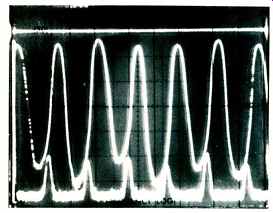
Fig.
7--Erasure of 400-Hz, 250-nWb/m tone on Nakamichi SX and ZX tapes. using
Geneva PF-250 bench-type bulk eraser and with tapes moved along its guide
rail. Top trace: Tone before erasure. Middle: ZX after erasure.Bottom:
SX after erasure (see text). Scales: Same as Fig. 3.
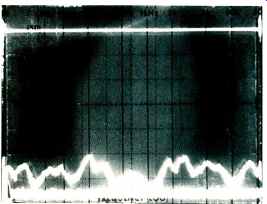
Fig. 8--Same as Fig. 7 but with tapes rotated in magnetic field (see text).
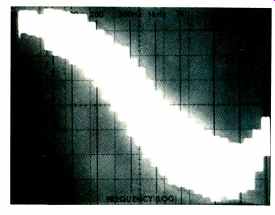
Fig.
9--Erasure of pink noise recorded on ZX tape with Dolby C NR, using Geneva
PF-211 bulk eraser. Range of erasure over time in each third-octave band
is shown by vertical spread of trace, with maximum erasure at bottom of
trace. Vertical scale: 5 dB/div., with-15 dB at top of screen.

Fig. 10A--Bulk erasure of open-reel tape. For best results. tape reel should
be rotated on spindle as it is erased.
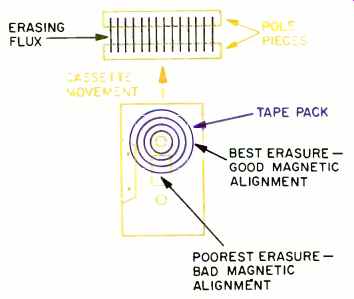
Fig. 10B--Cause of uneven erasure when cassettes are passed straight through
degaussing field.

Fig. 11--Erasure of Maxell XLI open-reel tape. Top: Spectrum analysis of
1-kHz tone recorded at 200 nWb/m. Bottom: Same tone after degaussing
by Tascam E-2A and Lafayette ML-120 erasers (traces partly overlap; see
text). Scales: Vertical, 10 dB/div.; horizontal, 20 Hz/div.
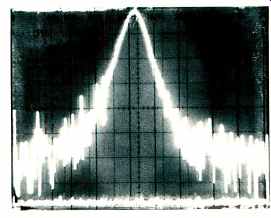
Fig. 12--Same as Fig. 11 but using Geneva PF-211 and PF-250 for bottom
(overlapping) traces.
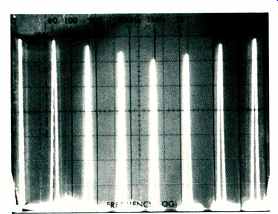
Fig. 13--Amplitude vs. time for erasure of 1-kHz, 200-nWb/m tone on EE
open-reel tape (TDK SA), using Geneva PF-211. Note un-erased sections, caused
by failure to scan the tape properly (see text). Scales: Vertical, 10 dB/div.;
horizontal, 2 S/div. 70.
(Audio magazine, Jan. 1988)
Also see:
Open Reel Recorders: Erasure and Demagnetization (April 1981)